 By Staff By Staff
May 3rd
BURLINGTON, ON
We all love food, so why are we throwing nearly half of it in the trash?
The Burlington Green people invite you to watch food lovers Jen & Grant take on quite a challenge.
 This couple vowed to quit grocery shopping and to survive solely on foods that would otherwise be thrown away fir six months. This couple vowed to quit grocery shopping and to survive solely on foods that would otherwise be thrown away fir six months.
The film takes a glimpse into our standards for food production, and where this system is failing, leaving millions of pounds of food in the landfill, and half the world malnourished.
When: May 5, 2016, 7:00 – 9:00 pm ( doors open at 6:30 pm)
Where: Burlington Public Library (Central Branch), 2331 New Street
Admission: $5/person
*Complimentary refreshments courtesy of Goodness Me!
This event is part of the 2016 Eco-Film Festival presented by BurlingtonGreen, the Burlington Public Library and Halton Green Screens.
Future films on the program:
This Changes Everything
June 2, 2016 (join us for our AGM beforehand!)
Directed by Avi Lewis, and inspired by Naomi Klein’s international non-fiction bestseller This Changes Everything, the film presents seven powerful portraits of communities on the front lines, from Montana’s Powder River Basin to the Alberta Tar Sands, from the coast of South India to Beijing and beyond.
Interwoven with these stories of struggle is Klein’s narration, connecting the carbon in the air with the economic system that put it there. Throughout the film, Klein builds to her most controversial and exciting idea: that we can seize the existential crisis of climate change to transform our failed economic system into something radically better.
Flight of the butterflies
September 22, 2016
This film is about the remarkable Monarch butterfly migration, the most incredible migration on Earth, and the determined scientist who spent 40 years trying to discover exactly where the butterflies mysteriously disappeared when they flew south for winter.
The True Cost
November 24, 2016
This eye-opening documentary examines how the developed world’s desire for cheap, stylish clothes has led to the widespread abuse of the Third World sweatshop labourers who make them, the degradation of local environments, the waste produced, and what the fashion industry can do to change the situation.

 By Staff By Staff
May 2, 2016
BURLINGTON, ON
The Halton District School Board will be recognizing Children’s Mental Health Week, May 2-8, 2016 with a range of activities offered at schools throughout Halton. These events will focus on mental health promotion and promote an awareness and understanding of the importance of wellbeing and practical mental health coping strategies.
Activities include:
• Munn’s Public School in Oakville will focus on the positive effects of being physically active. The school will host a Yoga day on May 3 and a Jump Rope for Heart event on May 6.
• Burlington Central School will host ‘Compliment Days’ and hand out apples to students as they enter the school in the morning to encourage healthy eating.
• Bruce Trail Public School in Milton students will post positive sticky notes or ‘thought bubbles’ throughout the school to encourage each other.
• Forest Trail Public School in Oakville will be hosting a ‘We Care Wednesday Appreciation Day’ in which students and staff members will express appreciation to one another.
• Stewarttown Public School in Acton will be incorporating a ‘May the Force Be with You’ theme including ‘Yoda Yoga’ and a ‘Jolly Jabba Walk’.
 Clara Hughes – Olympic medal winner and spokesperson for mental health. The week will culminate with the 3rd annual Halton Run for Youth Mental Health on May 7. It’s a collaborative effort between Halton District School Board, Halton Catholic District School Board and CameronHelps. More than 400 people have registered to participate. The event aims to unite students, families and staff to show their support for youth mental health and break the stigma.
“We are pleased to recognize Children’s Mental Health Week as part of our continued commitment to promoting the positive mental health and well-being of our students,” said Mark Zonneveld, Board Superintendent of Education (Student Services). “This is an important initiative as schools have a significant role to play in building skills and sharing knowledge to help promote wellness.”

 By Staff By Staff
May 2, 2016
BURLINGTON, ON
The Summer Live & Play Guide is one line and available in print now.
Registration for the recreation, fitness, sports and culture programs listed in the guide opens on Saturday, May 14 for adults 19+. Registration for all other programs is open now.
“We wait all year long for our great summer weather and now is the time to get out and play,” said Chris Glenn, director of parks and recreation. “The city and its partners have something for everyone with programs and events ranging from swimming lessons and splash pads to camps, concerts in the park, bocce ball and so much more, all offered at multiple locations around Burlington.”
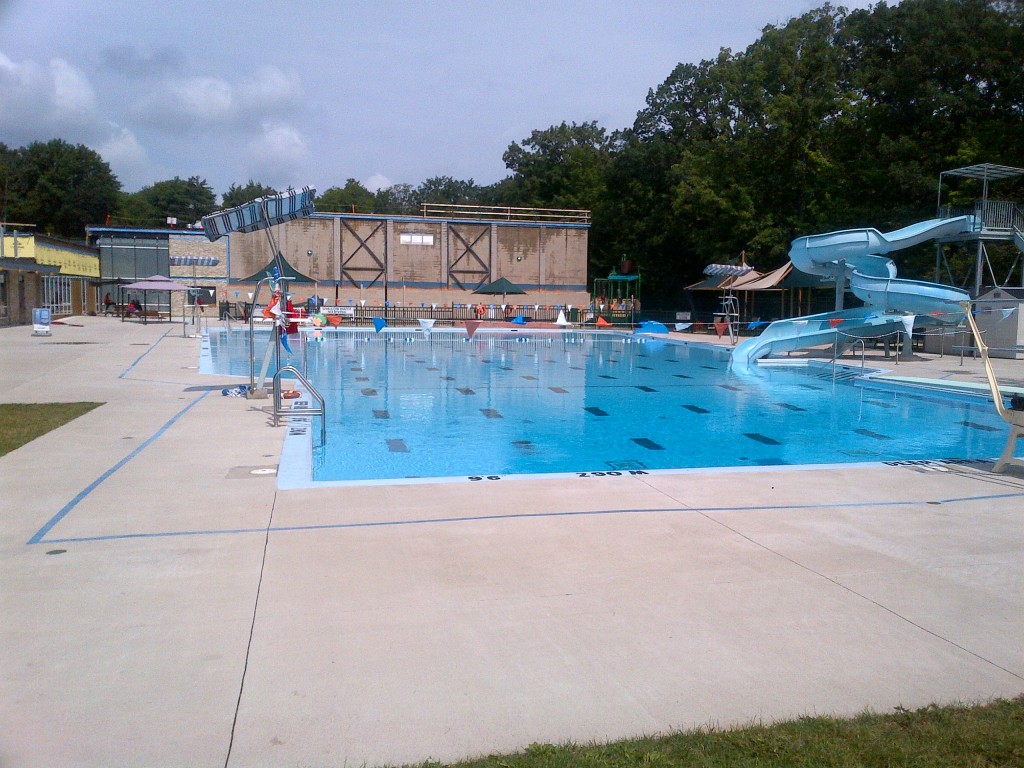 Mountainside Recreation Centre is featured on the cover of the summer guide. Recently renovated, this facility features a 50-meter outdoor pool with a one metre diving board, a double loop waterslide, shade structures, and a splash park, set to open on June 18. The park area of Mountainside features two playgrounds, a skateboard park, a basketball court and nature trails. A virtual tour of Mountainside Recreation Centre and park is available online. Mountainside Recreation Centre is featured on the cover of the summer guide. Recently renovated, this facility features a 50-meter outdoor pool with a one metre diving board, a double loop waterslide, shade structures, and a splash park, set to open on June 18. The park area of Mountainside features two playgrounds, a skateboard park, a basketball court and nature trails. A virtual tour of Mountainside Recreation Centre and park is available online.
The Summer Live & Play Guide is the City of Burlington’s guide to recreation, sport and culture programs and events offered throughout the city. The online Live & Play Guide allows residents to view available activities and register for programs directly. The online guide is mobile-friendly and allows pages to be easily searched and shared through email and social media. To receive future copies of the online guide by email, subscribe to the Live & Play e-newsletter at www.burlington.ca/enews.
Hard copies of the guide, printed on recyclable paper identified by the Forest Stewardship Council (FSC) logo, are available at City Hall, 426 Brant St., Burlington Public Library branches or any city recreation centre.
For details on how to register for summer programs and events, see page three in the guide or visit www.burlington.ca/play.
The Nelson pool will not be among the locations available for the summer program.
Nelson pool status.

 By Staff By Staff
May 2, 2016
BURLINGTON, ON
Halton District School Board announces a new award program launched this week by Trustees to recognize and honour “unsung heros”.
The Inspire Awards are designed to acknowledge the contributions and effort of ‘unsung heroes’ including staff, students, school volunteers, parents and community members. Anyone can be nominated for an Inspire Award and nominations can be made by anyone from any organization. The Inspire Awards launch today (May 2, 2016), as part of Education Week in Ontario, held May 2-6.
Through the Inspire Awards, Trustees aim to recognize all voices as a way to celebrate recipients who support staff and students through caring and innovative ways. Nominees can be honoured for their work in a number of areas including achieving diversity and equity, promoting 21st Century learning, encouraging environmental protection action, and supporting student achievement, among other themes. Specifically, this award will be given to an individual or group, formally or informally associated with the Halton District School Board, who has through their actions fulfilled the following criteria in an exemplary way:
• demonstrated caring, initiative, innovation, creativity;
• inspired others; and
• supported students and contributed to their achievement.
 Board Chair Kelly Amos. “We are thrilled to introduce the Inspire Awards to recognize those who go above and beyond to support our students,” says Board Chair Kelly Amos. “The definition of inspire is to excite, encourage or fill someone with the urge or ability to do something positive. In keeping with the Board’s multi-year plan, Trustees felt it was important to encourage and recognize the many unsung heroes who either work or volunteer in many capacities to support student achievement and learning in the Halton District School Board.”
Inspire Award nominations will be reviewed by a committee of Trustees. Each nomination will be evaluated on its own merit. The award recipient can choose to accept the honour during a Board of Trustees meeting or by any other way of their choosing.
Nomination forms, general information and Frequently Asked Questions can be found on the Halton District School Board website, www.hdsb.ca, under the ‘Boardroom and Trustees’ tab on the homepage.

 By Staff By Staff
May 1, 2016
BURLINGTON, ON
Dan Noonan of Argosy Securities took a bold step to strengthen and support a healthy community through a $100,000 contribution to the Burlington Community Foundation (BCF) that has established a new Mental Wellness Endowment Fund.
Colleen Mulholland, President and CEO, Burlington Community Foundation said: “As part of our mental wellness leadership work, we are thrilled to establish this new fund so we can focus on mental wellness through our granting program, now and in the future”. She added that Dan has demonstrated his commitment to the health of our community in numerous ways and this latest gift will provide an on-going legacy for many years to come.”
 Dan Noonan,third from the left, an Investment Advisor, Argosy Securities is joined by Burlington Community Foundation board members Catherine Brady, Phil Reddon; President and CEO Colleen Mulholland; Leighan Basadur, John Rockx. BCF is committed to supporting the community and focusing efforts on areas that are most in need. Data from BCF’s Vital Signs Reports over the last few years confirm that mental health issues are growing. And to add to BCF’s findings, recent research by CivicAction estimates that over 1.5 million people in the Greater Toronto and Hamilton Area’s (GTHA) labour force have experienced a mental health issue. That’s 1 in 2 people. Further, over the next 10 years, current mental health issues in the GTHA labour force could result in almost $17 billion in lost productivity.
Noonan said: “I believe that by supporting the strategic mental wellness efforts of BCF, our community will be strengthened for many years to come.” He added that the team at BCF is doing important work and hope this gift inspires others to get involved.”
The purpose of the Mental Wellness Endowment Fund is to improve mental health and wellness in our communities by supporting valuable mental health programs and services. With only 1 in 3 Ontario adults getting access to much needed programs and services, and sadly, only 1 in 6 of our children and youth getting access, BCF believes this fund will enable vitally needed support at the local level.
“We know that access to much needed mental health services can be a life-threatening issue facing many family members, children, neighbours and colleagues,” says Mulholland. “This generous gift to start a legacy of supporting mental wellness in our community is much needed and appreciated.”
The Burlington Community Foundation was established in 1999 as a centre for philanthropy. The Community Foundation collaborates with donors to build endowments, give grants and connect leadership to address our community’s most pressing needs. The Foundation is a 360 degree grantor, with over 78 endowment funds and $10 million in endowed assets. It has distributed $3.2 million in grants since its inception.

 By Staff By Staff
April 30th, 2016
BURLINGTON, ON
Some days it feels like there might be some snow coming our way. It is certainly confusing – is it spring or isn’t it. This confusion isn’t something that just happened – it is something we have let happen with the way we have treated this planet.
Our behaviour is changing – slowly.
The Regional government has set up programs that allow us to change the way we handle waste. They are committed to diverting waste from the landfill sites and working towards becoming more sustainable than we have been.
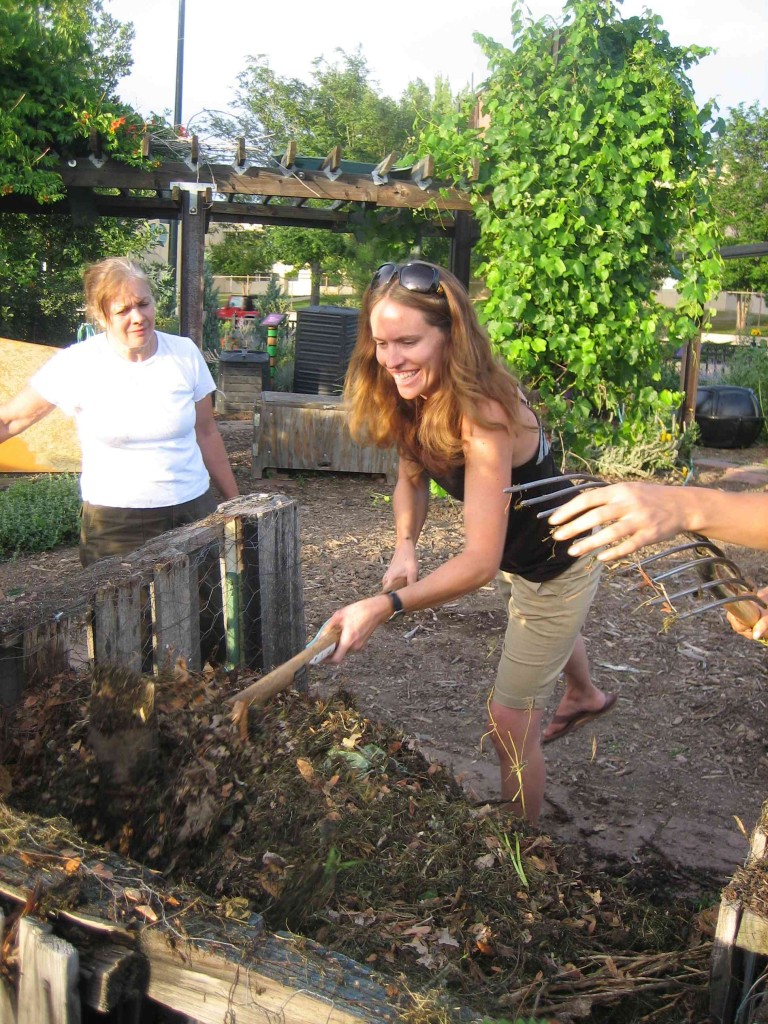 Composting – best way to get a garden to really produce – and it is free. As part of this commitment the Region will once again offer its popular spring waste events. The Region offers these services to help divert waste from Halton’s landfill by making it easy for residents to properly dispose of waste, helping Halton become a more sustainable place to live.
“Regional Council is committed to protecting and enhancing our rich, natural environment by continuing to work with residents to increase the Region’s waste diversion rate,” said Halton Regional Chair Gary Carr. “Our spring events not only provide residents with an opportunity to properly dispose of waste, but gives residents an opportunity to give back to the community.”
This year’s spring waste events include:
Spring Compost Giveaway
Residents can stop by the Halton Waste Management Site (HWMS), located at 5400 Regional Road 25 in Milton, to pick up high-quality compost free of charge. Residents are reminded to bring their own bags or containers (maximum seven garbage bags or equivalent per household) and a shovel in order to bag their compost.
If you ever wondered how that compost is prepared – take a peek at the short video – the Region has done some useful educational work. Click here for that video.
Hours of operation are:
Monday, May 9 – Saturday, May 14; 8:00 a.m. to 4:30 p.m.
Sunday, May 15, 8:00 a.m. to 12:00 p.m.
Last year’s Compost Giveaway events, 4,400 residents picked up approximately 2,000 tonnes of compost. Residents also donated $9,784 and close to 4,500 kilograms of food to local food banks as part of the event.
Special Waste Drop-off
To make the recycling of household hazardous waste and electronic waste more convenient for residents, Halton Region hosts several Special Waste Drop-off Days through the year, free of charge. The first event for 2016 will take place on Saturday, April 30 at Robert C. Austin Operations Centre in Georgetown from 8 a.m. to 2 p.m. Residents are invited to drop off acceptable items, including pesticides, paint, motor oil, antifreeze, propane tanks, computers, stereos, TVs and DVD players. This event is for Halton residents only. No commercial waste will be accepted. For more information and a complete list of acceptable and unacceptable hazardous items, visit halton.ca/dropoff.
If you need more information visit halton.ca/waste or dial 311.

 By Pepper Parr By Pepper Parr
April 29th, 2016
BURLINGTON, ON
A young musician who got hooked on history from her music teacher in high school is going to take to the stage of the Performing Arts Centre May 12th and put on a performance that is a combination of her playing her flute and film clips about the composers who wrote the music she plays.
The film clips are not going to be dry or dusty history explains Hayley Marie. The music during the period of time she is focused on – 1870 – 1910 was boisterous, ribald and vibrant and has been with us for more than 100 years. Titled “An Evening in Paris” the performance entertains and informs – you will see classical music a lot differently when you walk out of The Centre.
 The classical music we know today came out of that period when Debussy, Ravel, Saint Saens,Faure, Wido rand Satie were both writing and performing. The classical music we know today came out of that period when Debussy, Ravel, Saint Saens,Faure, Wido rand Satie were both writing and performing.
France had taken a terrible beating during the Franco Prusian War during which there was a 135 siege of Paris forcing people to eat horsemeat. France was prostrate on the world stage.
It was out of that terrible defeat that France rose politically, economically but most importantly culturally.
The world saw the first of the Impressionists –Renoir and Monet were painting during this period. And the music just flowed.
Hayley Marie ties together both the music and the story behind the men who wrote the music. It is fascinating – gossip at its very best. She has a fierce interest in preserving the human side of classical music fired by a desire to show how these musical giants interacted with the society they were a part of – it wasn’t’ always a pretty picture.
 Hayley Marie Remple Concert goers in the Paris that Hayley Marie Remple talks about was not polite society. Applause was loud, displeasure resulted in booing and throwing fruit at a performer. Patrons were known to jump up on their seats and shout. Fisticuffs were not unusual – Passions of people who were fully informed about the music they were listening to rose quickly – and everyone had an opinion.
The composers were real people with real problems, some had significant addictions and some had personal lives that would rival anything you read about Mick Jagger or Elvis Presley.
Hayley Marie, a Governor General Award winner and three time performer at Carnegie Hall walks on to a stage to present a performance that is part of a month long five province tour.
Remple has performed in southern California, Connecticut, Montreal and Winnipeg. In 2009, she completed her first concert tour of Germany and France.
A century after the deaths of these towering composers scholars are still studying their work and music The France she is going to reflect built the Eiffel Tower and created the statue of Liberty that was given as a gift to Americans.
May 12th – 7:30 pm
Performing Arts Centre
Tickets $35
Box office

 By Staff By Staff
April 27, 2016
BURLINGTON, ON
There are parents that believe bribing your child to do something is easier than direction and discipline.
The city may be listening to these people.
Burlington and Healthy Kids Community Challenge have partnered with Metrolinx to encourage local teachers and students to register their schools for Bike to School Week, taking place from May 30 to June 6.
 There wasn’t enough room for all the bikes at this school. “We know from Halton Region’s Active Transportation and Health report that close to 40 per cent of Halton residents aged 12 and older were largely inactive during their leisure time over a one-year period between 2013 and 2014,” said Mayor Rick Goldring. “We want to help change that figure, and cycling is a great way to get active and improve our health while seeing Burlington from a different perspective on two wheels.”
The province came to the realization that there were too many kids focused on either their cell phone or their tablet and the waist measurement were beginning to climb.
They came up with a program that funnelled money into communities to get kids off their duffs and get more exercise
Burlington is a city that has traffic jams in front of some schools and reported fisticuffs at others over the stopping of cars that were dropping kids of at schools.
In Burlington the delivery of the Healthy Kids program got passed along to Community Development Halton which has done a remarkable job of getting into communities, especially those with a lot of financially disadvantaged children, and creating after school and evening events.
 Brant Street where the Regional Police use bicycles on a regular basis as part of the way they do their work. Are there any other civic employees using bicycles? The model has been taken up by a number of other communications – even though city council had some difficulty fully buying into it.
The Healthy Kids Challenge is tying into the Bike to School Week event. Schools that register for Bike to School Week by May 6 will be entered into a draw for a chance to win one of 20 bike racks, provided by Healthy Kids Community Challenge Burlington and the city, for their school.
In addition, schools that sign up to participate before the close of registration on June 1 will be entered into a draw to win a Can-Bike rodeo for their school in the 2016-17 school year.

 By Pepper Parr By Pepper Parr
April 26, 2016
BURLINGTON, ON
The city’s Sustainable Development Advisory committee is getting out into the community and showing citizens what sustainability is like at the ground level.
The advisory committee often gets bogged down in writing reports and commenting on projects the city has sent them for review.
They produce an impressive annual report which unfortunately didn’t get much attention after it was submitted – copies are sent to the library and that’s about all the coverage the document gets.
The SDC, acronym for the Sustainable Development Committee are getting out into the community and sponsoring a Jane’s Walk through Spencer Smith park and the Beachway early in May – the 8th
 The Spencer Smith Park we know today – pictures of what it used to look like are in the background articles. The story of how the city recovered land along the edge of the lake and created one of the more impressive parks in the province – giving people wonderful access to the lake is one of Burlington’s crown jewels.
 Spencer Smith Few know who Spencer Smith was and what he means to the city. Mark Gillies, one of the Gazette’s from time to time contributors, did an excellent profile of Spencer Smith – there is a link to that profile below.
It will be interesting to hear what the Jane’s Walk guide has to say about the way the waterfront was developed to what it is today.
The walk will move into the Beachway – a part of the city with a rich, colourful and controversial history. It was never a “tony” part of town – it had a railway line running through it and at one point it had its own small newspaper.
It was once a robust community with hundreds of homes that were on leased land that the city eventually took ownership of – the leases were brought to an end and the homes got to meet a wrecking ball.
 Beachway homes – they never want to leave – will they eventually be forced out? There are still some 25+ homes in the Beachway – occupied by people who have been there for generations and want to remain in the community. Other residents are hanging in looking for a better offer from the Region which has a mandate to buy every property on what they call a willing buyer – willing seller basis.
While this war of attrition goes on between the region and the residents the Region’s planners are working up plans for a massive series of parks that will – if it ever comes to pass – will be the envy of communities across the province.
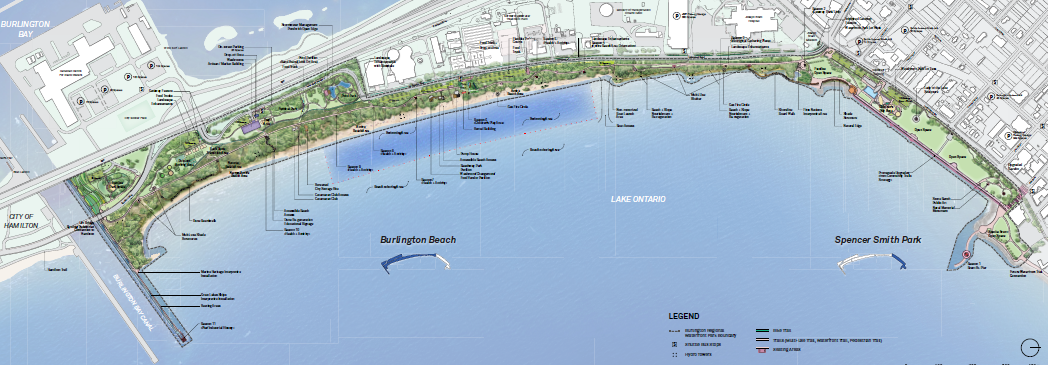 The remake of the Beachway community is massive in both concept and scale – it will be decades in the making and what the planners are thinking today might be quite different than the end result. The pier is a pimple when compared to the park plans. Most people in Burlington have no idea what the Region has planned for them – after the first announcement when the early thinking was made public, the Region went to ground – not a word from them in the recent past.
Will the Jane’s Walk shed any light on what is being done? Not likely.
Jane’s Walks were created to remember Jane Jacobs, an American who moved to Toronto in the xxx and became part of a group of activists who wanted to see better development in that city with more citizen input.
Hopefully the SDC will be true to her principles.
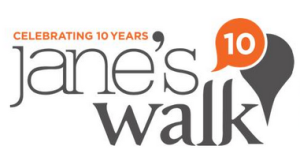  Jacob’s, who would have turned 100 years old this year, upended the fields of city planning and architecture with her 1961 book, The Death and Life of Great American Cities. She was described as the most influential urban thinker of all time. Jacobs once said: “Cities have the capability of providing something for everybody, only because, and only when, they are created by everybody”? Jacob’s, who would have turned 100 years old this year, upended the fields of city planning and architecture with her 1961 book, The Death and Life of Great American Cities. She was described as the most influential urban thinker of all time. Jacobs once said: “Cities have the capability of providing something for everybody, only because, and only when, they are created by everybody”?
The walk will begin at 1 pm – gather at the Compass in the park.
Background:
Spencer Smith – Part 1 by Mark Gillies
Spencer Smith – Part 2 by Mark Gillies
The struggle over the Beachway homes
The plans to turn the Beachway into a park.

 By Pepper Parr By Pepper Parr
April 26, 2015
BURLINGTON, ON
 The man in the green T shirt on the left is a member of the provincial government who was in town a few wars ago to announce funding for BG to plant tree seedlings in the Beachway. The announcement was made a number of years ago – the province created a Great Lakes Guardian Community Fund that funnelled money into the city via BurlingtonGreen to plant seedlings in the Beachway area where the environmentally sensitive sand dunes need plants and tress to anchor the sand.
The BG people were given $12,960 by the province for the planning, creation of three new signs, supplies, plant and tree stock
After a very successful Clean Up event last weekend – 11,000 plus people took part – Burlington Green is holding a Green Up event – collaborating with Halton Region, Conservation Halton and the city.
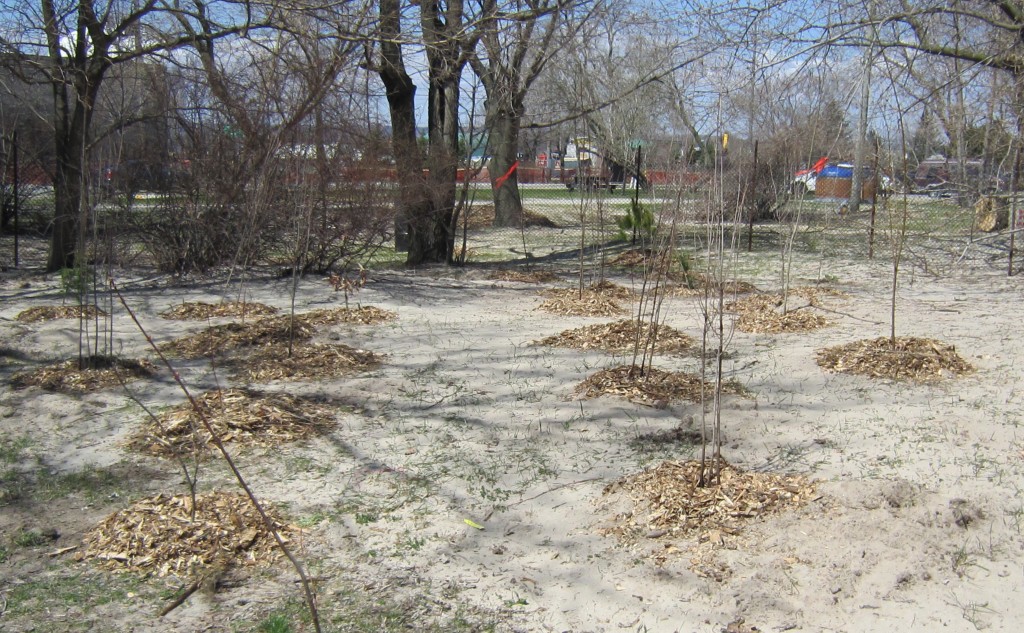 Seedlings planted in 2015 in the Beachway – what will they look like in 20 years? Hundreds of seedlings will be planted and invasive species of flora will be pulled out and trashed. The Region, Conservation and city work with Burlington Green to determine the location of all the plantings and interpretive signs.
The Clean Up involved thousands – the Green Up is limited to just 100 volunteers. The planting of the seedlings is city building at its most fundamental level – the plants that are pushed into the ground are going to be there hundreds of years from now. It will be a warm, welcome experience for the 100 volunteers to walk through the Beachway in 20 years and see their trees growing.
The Region is beavering away on a plan to totally revise the Beachway from the community it now is to a rather spectacular park. The planting of trees now is all part of the evolution of that community.
The Green Up event takes place on Saturday May 28 – runs from 8:45 to 12:45 with refreshments being served.
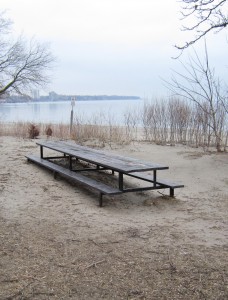 The sands on Beachway do shift. Much of the Beachway is a dune, the only one in the Region and very environmentally sensitive. The sands in th area actually shift over time.
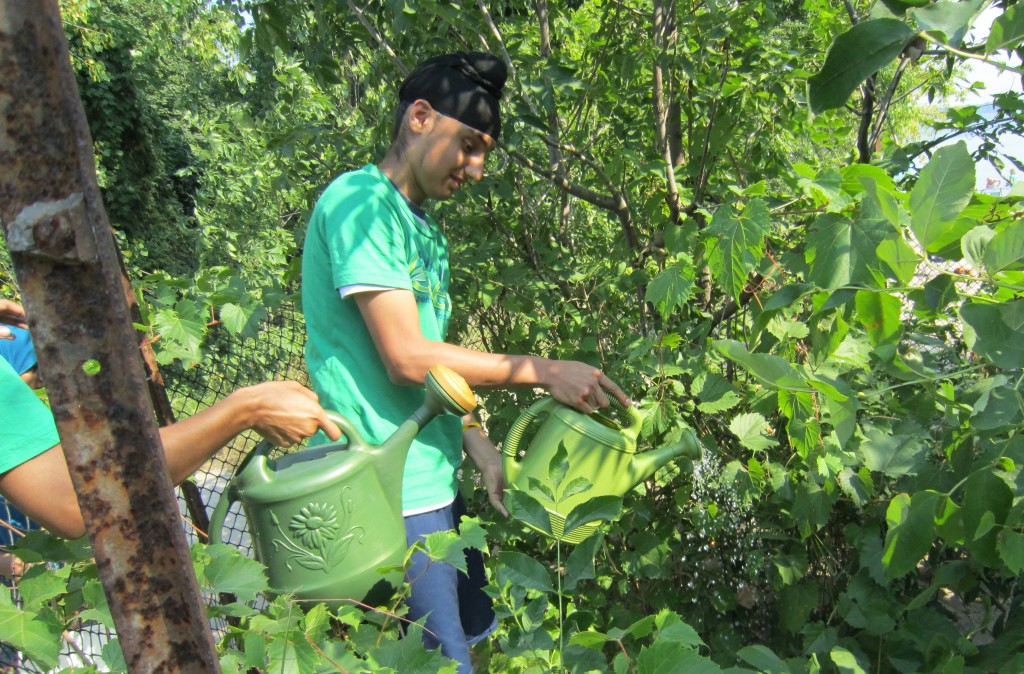 BurlingtonGreen members water plants and shrubs they planted along the Beachway Park two years ago. Volunteers will be in the area late in May to continue this work If you want to be part of this event – go on line and register – there is room for just 100 people – they will be city building for that half day.
BG volunteers have been doing this work since 2013. This year they will be planting native trees and plants.
Register HERE.

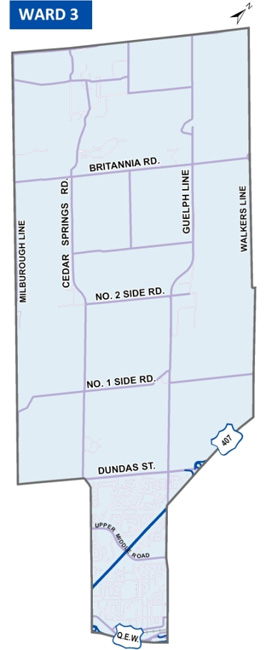 Ward 3 is a mix of suburban and rural – everything south of Dundas is easy to serve – it is the rural parts of the ward that are both demanding and hard to serve.  By Pepper Parr By Pepper Parr
April 26th, 2016
BURLINGTON, ON
Way back in 2010 two of the people who now sit on city council got themselves involved in the Shape Burlington committee, a group appointed by then mayor Cam Jackson to prepare a report on how well city hall was engaging the citizens of the city.
There was a lot of chatter at that time about city hall’s inability to hear what citizens were saying.
Two of the people on that committee, Paul Sharman and Blair Lancaster went on to throw their hats into the municipal election ring and got themselves elected – then they apparently forgot much of what the Shape Burlington report was all about.
At the same time Marianne Meed Ward was delegating consistently on the problems with the way the city was developing the waterfront area. She was instrumental in creating Save our Waterfront which sort of evolved into her campaign team and she too went on to get herself elected to Council.
While Meed Ward wasn’t part of the Shape Burlington group she was the one who remembered what the report was all about and created a constituency organization that spoke for the citizens in her ward and anyone else in the city who asked for help. And for the most part Meed Ward delivers.
All this is passed along as background on how people in this city get themselves elected to city council.
Burlington currently has two members of Council who have both been on the public payroll for more than 20 ears and are showing the wear and tear of public life. In their early years what they got in the way of remuneration wasn’t all that much to talk about.
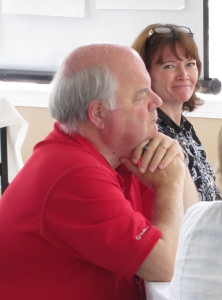 John Taylor, Ward 3, has seldom had anyone worth more than the votes they get from family and friends run against him – other than Cory Judson, Taylor has never had to fight off a real candidate. John Taylor, Ward 3, has seldom had anyone worth more than the votes they get from family and friends run against him – other than Cory Judson, Taylor has never had to fight off a real candidate.
There appears to be an individual in ward 3 laying the ground work for a run at that seat.
When you cover municipal politics long enough you can see the potential candidates from some distance. They become active in the community and begin to groom themselves for the opportunity to run.
We saw that with both Lancaster, Sharman and Meed Ward in 2010.
In the 2014 election there were not the same calibre of candidate presenting themselves. In ward 6 there were ten people who ran for office – most were very inappropriate as candidates; they were not known and had done next to nothing in their communities. Vanessa Warren and Jennifer Hlusko were the exceptions.
In ward 3 – in 2014 – there were two candidates running against John Taylor who had little hope of gaining public office.
It looks as if it is going to be very different in 2018 – there is a gentleman who serves on a major Advisory Committee who appears to be grooming himself for that seat.
John Taylor is reported to have said to some people that he will not run again but that he will join BurlingtonGreen and become part of that committee.
Many thought ward 3 stood little chance of getting a decent member of Council when Taylor hangs up his boxing gloves.
That does not appear to be the case.
Stay tuned.
Background:
Shape Burlington Report – a seminal document.
City response to the Shape Burlington report. Long and boring; did the people who wrote the report ever read it?

 By Staff By Staff
April 23rd, 2016
BURLINGTON, ON
The weather cooperated; the 11,000 people who signed up were still doing so at close to midnight on the Friday for the Saturday event during which those thousands helped Clean Up the city.
There were 181 locations where people were picking up trash recorded.
Instead of the usual gathering at city hall – people gathered at Central Park in front of the band shell where Turtle Jacks once again served burgers to the hungry environmentalists.
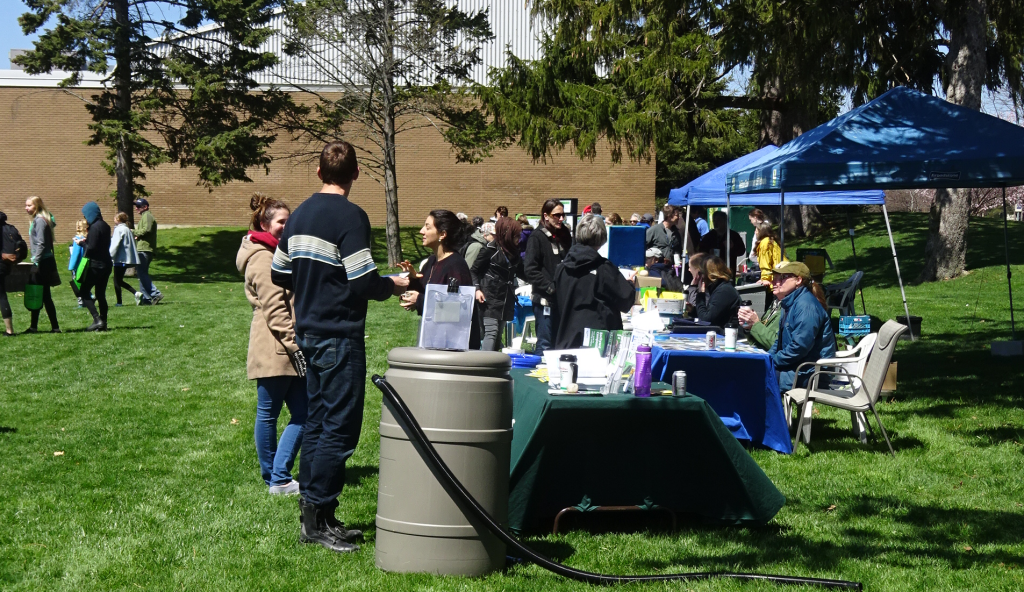 The gathering after the Clean up took place in Central Park this year. smart move – plan is to hold the get together outdoors every year. 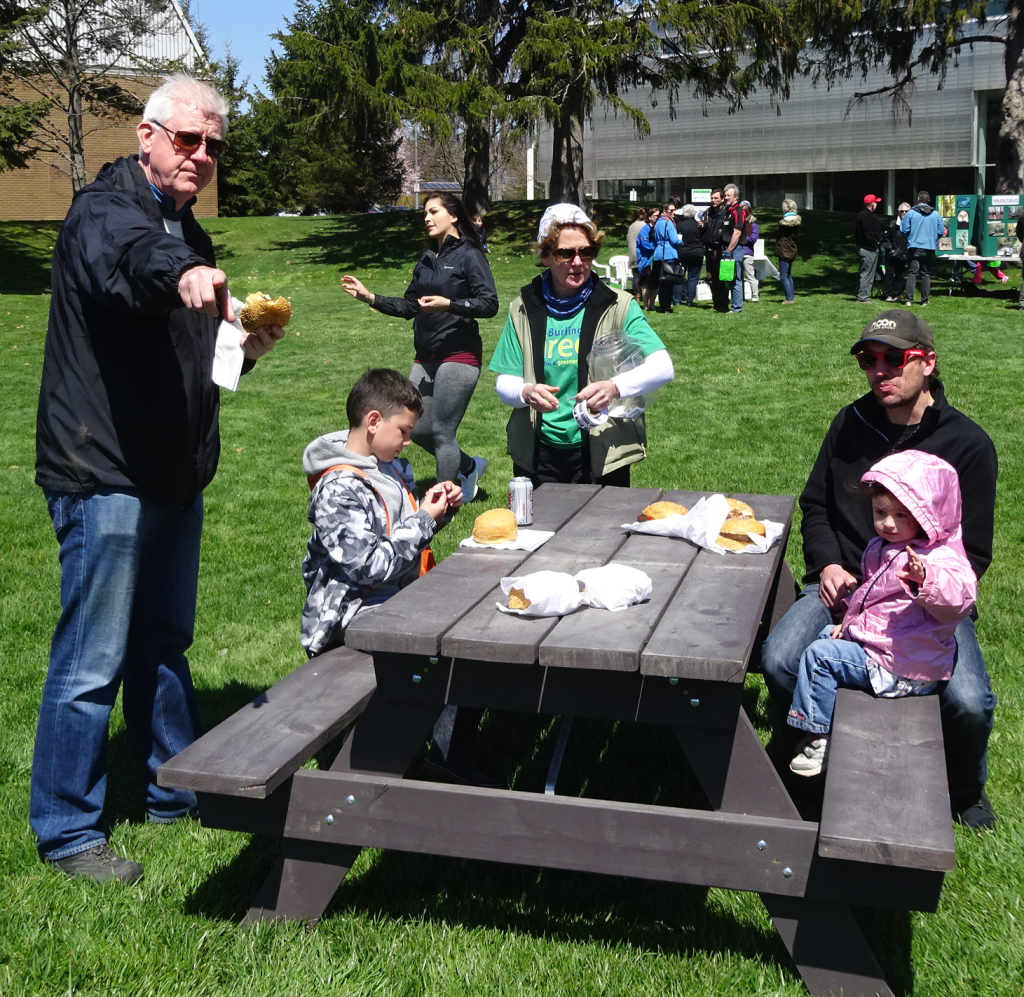 This is what a proud grandparent looks like -Councillor Paul Sharman, the only member o Councillor we say wants his granddaughter to look into the camera. The Mayor arrived later to say a few words.  Music was part of the event – look for additional performers next year. The decision to move outdoors was a welcome one. There was all kinds of room and while the crowds were not great the move was a wise one.
In time gathering outdoors on the Clean Up day will be the place to be.
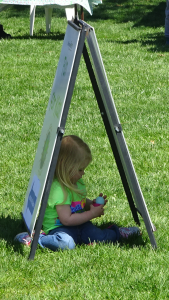 It was warm enough to be in short sleeves 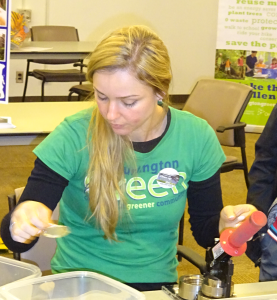 BurlingtonGreen volunteer makes badges from art work created bu the kids. There were displays and activities in the library where kids could have their unique badges made and other could colour.
There was a room set up with a video and Vince Fiorito was on hand to show people how to make seed bombs.
There were fewer speeches this year – and that has to be a blessing.
Burlington has to have one of the most impressive turnouts when it comes to volunteering at this significant event – kudos to the BG board for making this happen each year.

 By Staff By Staff
April 18, 2016
BURLINGTON, ON
It is one of the largest and most effective city – community groups Burlington has. They both advocate for the environment – they try hard, but not always successfully to hold city council accountable for the decisions they make that impact the environment.
BurlingtonGreen has initiated a number of projects that make a difference and they have invited world class speakers to the city. It is an organization that has real clout – it could be used more consistently and with more vigor at times.
REGISTRATION link is at the bottom of the page.
 Every age gets involved in the annual BurlingtonGreen Clean Up Every Spring thousands of citizens pull on a pair of gloves pick up a green plastic garbage bag and go picking up litter anywhere they can find it.
Called the Clean Up – it takes place on a Saturday morning with everyone, in the past, gathering at city hall for a burger, pop and a chance to chat up their friends.
The Clean Up this year takes place on Saturday the 23rd – people can go to the BurlingtonGreen web site and decide where they want to do their community work and just show up.
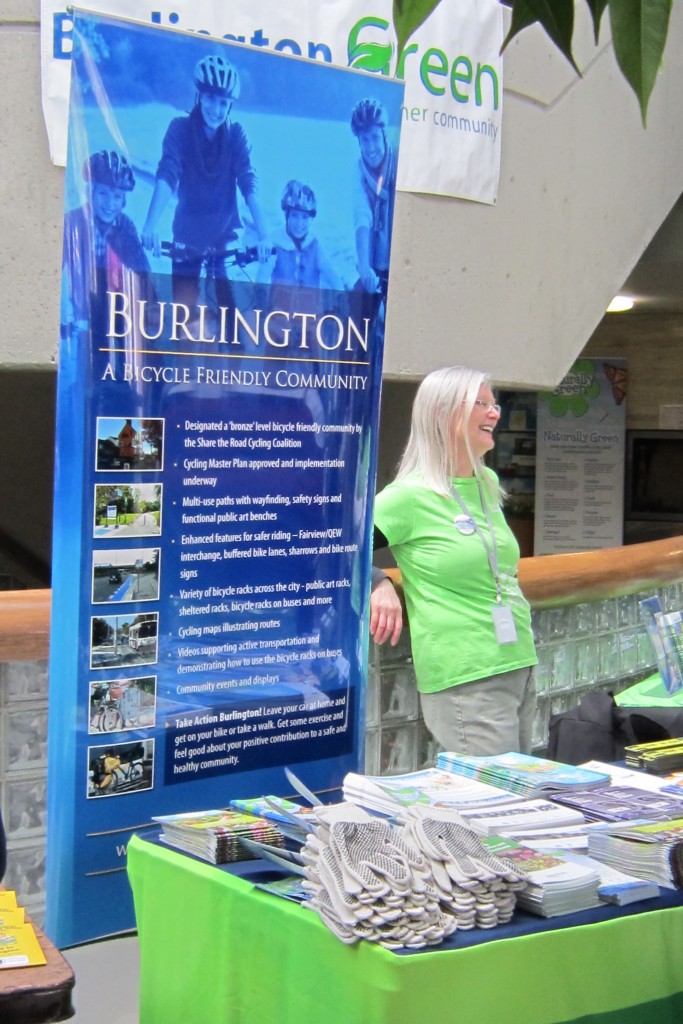 The annual CleanUp campaign Burlington Green organizes ends with a gathering of the environmental clan – this year it will be at the Bandshelll in Central Park – right next to the library. There are perhaps hundreds of places to Clean Up – when the work is done everyone is encouraged to gather at Central Park and wander around the exhibits at the library or listen to music and have their burger and chat with friends on the grounds in front of the band stand. Entertainment is expected to be part of the event.
More than 55,000 participants have joined the collective effort resulting in cleaner parks, streams, school yards and neighbourhoods.
This citywide event invites citizens, schools, churches, businesses, neighbourhoods and community groups to come together to clean up and green up Burlington to help the planet locally. What a great and meaningful way to celebrate Earth Day 2016!
Registered Clean Up participants will receive free supplies (bags and gloves) to do their clean up activities and are invited to attend an Eco-‐fair Celebration at Central Park Bandshell/Library on April 23rd from 11:00am to 4:00pm. Festivities will include a BBQ courtesy of Turtle Jack’s and refreshments courtesy of Tim Hortons, along with fun button making for kids, a variety of local eco-‐display and opportunities to win free raffle prizes.
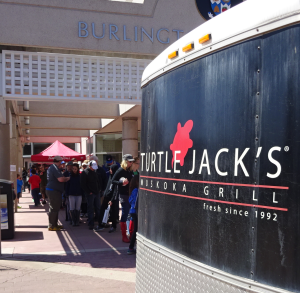 Turtle Jacks will be there with their mobile kitchen. The line ups move quickly. There will be displays inside the library and music at the bandshell.
 Amy Schnurr, Burlington Green’s Executive Director explains that this is the 6th year the city and the BG people have worked together. It started in 2011 she said. BG and the City partner on this event with the City contributing $7,000 from the Parks and Road maintenance budget for event planning and execution costs. Amy Schnurr, Burlington Green’s Executive Director explains that this is the 6th year the city and the BG people have worked together. It started in 2011 she said. BG and the City partner on this event with the City contributing $7,000 from the Parks and Road maintenance budget for event planning and execution costs.
Registration gets done – just click here:

 By Pepper Parr By Pepper Parr
April 18th, 2016
BURLINGTON, ON
It was pretty simple to Griffin Gervais, a grade five student at Lakeshore Public school – just ask people how to get the ball diamond behind the school repaired and they would tell him what was needed and it would get done because he was the kind of kid that did things like that.
 Carrie Gervais and her son Griffin at Matching Fund meeting. Griffin had an occasion to meet Burlington’s MP, Karina Gould and asked her if she would help him with his plans for the ball diamond. The grounds needed a serious leveling out – they had little rises and small shallow spots. The bases needed bags that were properly anchored – third base is currently a small hole that collects water.
The back drop is close to being ready to fall down. And the benches are kind of crappy.
The ward 2 member of city council happened to be at the same event – Gould pointed Griffin to Meed Ward who was pretty sure what Griffin and his buddies wanted to do was possible under a program that was being rolled out by the city’s parks and recreation department.
 The city had created a Neighbourhood Community Matching Fund that could put up as much as $5000 into a project that is designed to improve a community. The city had created a Neighbourhood Community Matching Fund that could put up as much as $5000 into a project that is designed to improve a community.
If the success of the Neighbourhood fund depended on the effort of the Parks and Recreation people overseeing the program – the thing would be a raging success.
The purpose of the program is to get people involved in their communities by pulling together a group with a common cause.
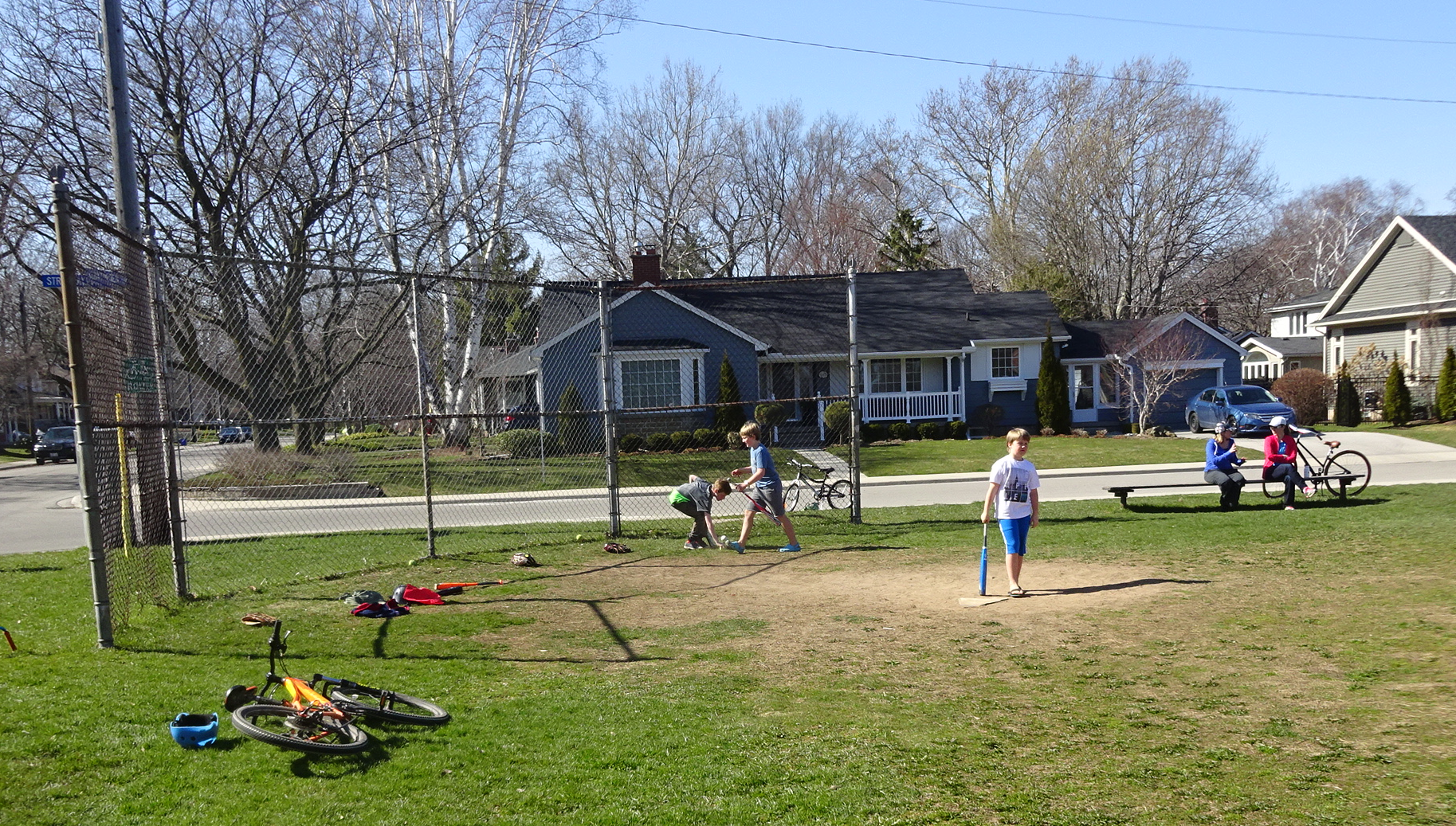 Home plate is the only base that has a bag – and it doesn’t line up properly with the other bases. As a school play ground it has been allowed to deteriorate badly. The Neighbourhood Community Matching Fund has Griffin Gervais’s name written all over it.
City hall staff were spending time in each ward meeting with people to explain what the program is and how it works.
They were in ward 2 last week explaining the program and taking people through the forms that have to be filled in. There are a lot of forms to be filled in.
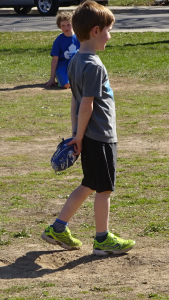 No base bag at third base – just an indentation in the ground where water gathers. 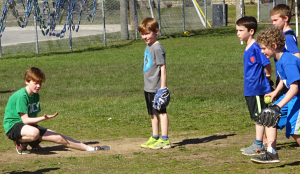 Was he out – Griffin Gervais didn’t think so – but there was no base bag to really know. To use the language of the retail sector – these people want your business and they will go well out of their way to make what you want to do in your community happens.
Julia Rogers, the lead contact person and the one who does the presentations, gets herself pretty wound up when she speaks. Griffin Gervais who as at the meeting with his Mom wants to see that baseball diamond at his school upgraded.
Traditionally, in Burlington at least, the school board and the city don’t cooperate all that well.
That isn’t slowing down the people running the Neighbourhood Matching Fund. They appear prepared to do whatever they have to do to get a spark going within a community that will grow into a nice flame that will ignite people in their communities to come together and do things that make Burlington a better place for everyone.
Carrie Gervais said she now has the quotes she needs from the Board of Education so “we now know what the target is. The parents added $200 to the budget for a party in the park to celebrate their success which is all part of the city’s objective. They want people to come together, work together to make their neighbourhoods better places.
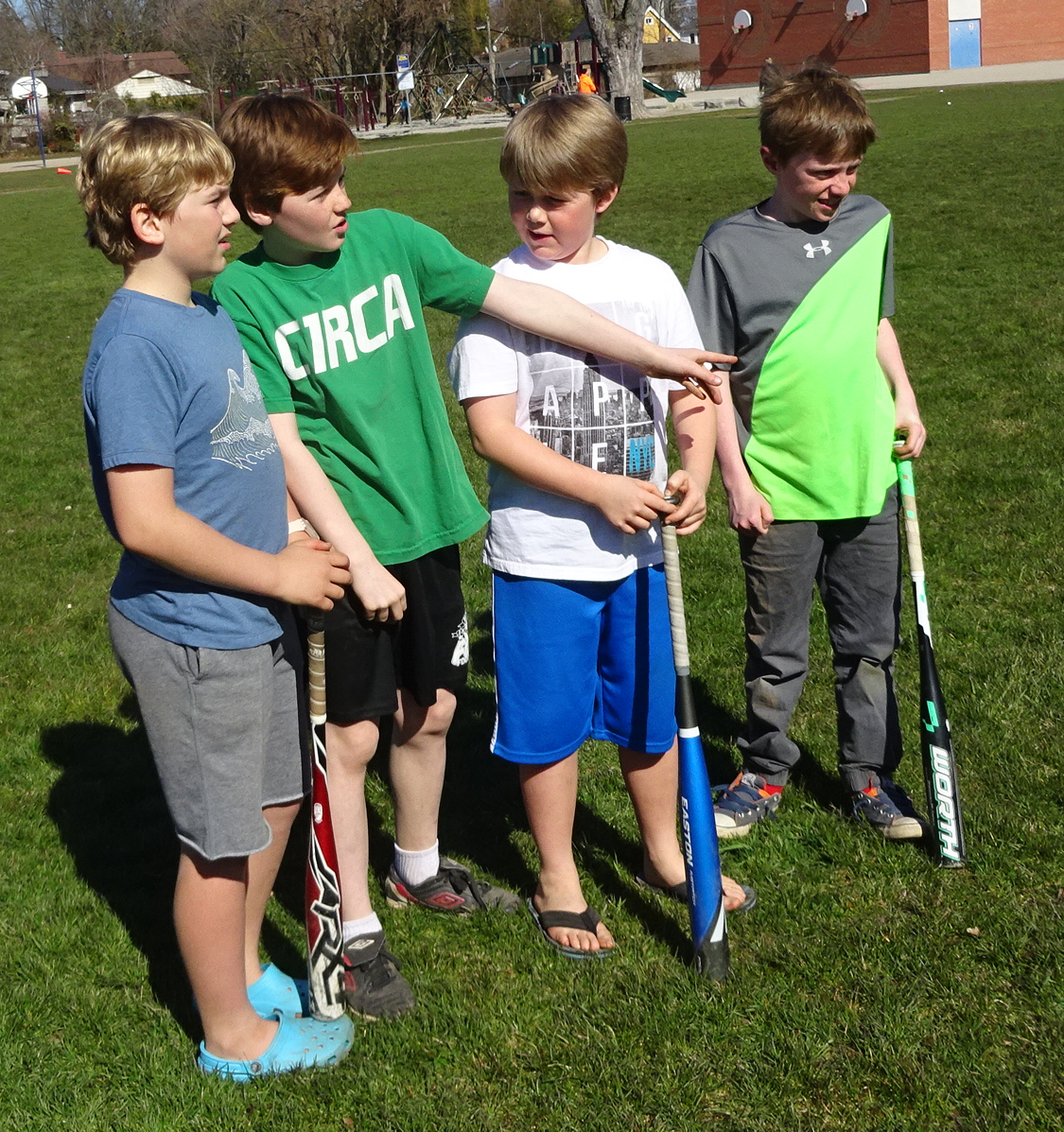 In no specific order: Sawyer Cobham. Scott Rose, Griffen Gervais, Kayden Maslanyk discuss the problems with their ball diamond The Matching fund is intended for a project people want to see done in their neighbourhood. The forms are not that difficult – everything is on line – and if you have a problem – the staff are there to help you.
The city has set aside $50,000 for the program this fiscal year.
Applications have to be in no later than April 29th – which doesn’t leave much time. Staff actually apologized for the late start – this is the first year of what they see as a multi-year effort.
There are two completed applications in hand with one coming in from Giffin and his buddies. There are six wards in the city – someone is going to be disappointed.
Every project submitted won’t need a full $5000 explained Rogers. So the $50,000 available for this year is expected to cover all the applications.
If the program works – parks and recreation staff are planning on asking for more funding for future years.
The City has been pumping out media releases to remind residents that applications are due Friday, April 29.
Chris Glenn, the city’s director of parks and recreation believes there are a lot of good ideas out there and says:. “If you have a proposal for something you think would bring your neighbourhood and community together and build strong connections, we want to hear about it. Even if you are not able to complete all of the information requested in the application form, I would encourage you to still submit it to the city by the April 29 deadline.” Glenn added that once a project is approved the sponsoring group has up to one full year to complete the work.
Griffin project is going to come in at about $11,000 – they are hoping they can get a full $5000 from the city and fund raise to pull in the balance.
The community is expected to raise half of the amount needed. That half can be cash, or in kind materials. Any work that people do on the project is counted at the rate of $17.02 for each hour worked. 50% of any professional services that are needed can be included in the budget.
Griffin’s parents set up a crowd funding account at: Gofundme.com/myzjbcwk There are no stones unturned with this group.
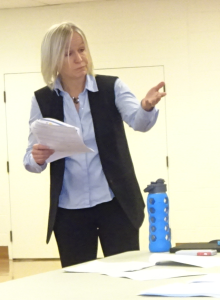 Julia Rogers will guide anyone through the application process. It sounds a little complex – don’t worry about figuring out the details – Julia Rogers is a phone call away and she will take you through the application form line by line.
One of the issues on anything that involves the city or the board of education is insurance. That can be difficult to navigate. Denise Beard, Manager Community Development, said her staff will do everything they can to get you the insurance coverage you need.
Applications need to be in before the end of the month – approved projects will be announced in June.

 By Staff By Staff
April 16, 2016
BURLINGTON, ON
The public school board say they want your opinion and have created a Tell Them From Me survey that is available on line – but they forgot to say just where the survey is on their website. We will check in with these people on Monday and get that information for you.
How effective is the public school board system?
Are you getting what you feel you need for the education of your children?
What does accountability mean?
Is accountability a two way street?
The people who deliver services to the public need to know what you think – if they don’t get public input they are left to do what they think is best – which isn’t always the best. Citizens have a responsibility to advise – this is your opportunity.
 Students from across the Region took part in a Skills competition in Burlington. From April 18 until May 13, 2016, all parents/guardians with children in the Halton District School Board are invited to complete the Tell Them From Me – Our School parent survey. Parents/guardians will be emailed instructions and a link to the survey starting April 18.
Parents will be asked about issues related to learning opportunities, communication, school culture, and climate. The information gathered from the survey is being used to help schools continue to create positive school climates, to inform annual bullying intervention plans, and for parents to have a voice in creating a supportive community at their school.
Students and staff are invited to complete their own Tell Them From Me survey at school. Individual responses are always grouped together for analysis. Parents may complete their survey online from wherever Internet access is available. If you do not have Internet access, please discuss alternatives with your child’s school administrator.
If you have any questions about the surveys please contact Frank Nezavdalf, Department of Research and Accountability, (905) 335-3663 ext. 3381 or by e-mail: nezavdalf@hdsb.ca.
If you have any difficulties accessing the survey or require technical assistance please contact the HDSB Information Centre at 905-333-4372 (HDSB) or 1-888-432-4372 (HDSB), Monday to Friday 8 a.m.-4:30 p.m. or by emailing informationcentre@hdsb.ca
They both want and need you opinion – it is your children they are there to educate.

 By Pepper Parr By Pepper Parr
April 15, 2016
BURLINGTON, ON
There are now have 694 Insight Community members!
In a city this size there should be at least 2500 people
Insight is the service the city has to do almost instant polling of a group of people that are fully representative of the community.
 The service was not cheap – $100,000 a year – but it is a very useful and for the most part a very accurate tool to measure public opinion. The service was not cheap – $100,000 a year – but it is a very useful and for the most part a very accurate tool to measure public opinion.
The panel is becoming more evenly spread demographically and is sitting at 53% Male, 45% Female (2% of you preferred not to answer).
It is now quite evenly split of over the six wards in the city. The numbers have grown with each and every survey put out to the public, where there has been the option of joining the community.
The Gazette has heard of people who were not accepted into the polling group and they concluded the city knew who they were and didn’t want them within the polling group.
Nothing could be further from the truth – the city knows a lot about the people within the group – except for one thing – who you actually are.
They know your age, what you earn, where you live, what kind of a home you have, if you use transit, your education – all kinds of data – but they don’t know your name.
What polling needs is a balance in the group questions are being put to – which means you might be a 42 year old male with a college education – they may have enough of those – but need women who are single with a post graduate degree.
If you are interested in being part of the panel – apply – the people who run the service will determine if you fit into the balanced panel they maintain.
Being turned down doesn’t mean they didn’t want YOU – it meant that there were already enough people like you on the panel.
If you want to follow up on this CLICK HERE and you will get to the Insight page on the city web site.


By Ray Rivers
April 15, 2016
BURLINGTON, ON
Peace and quiet – not what I expected to find in a city with three million people, the eighth largest in Europe and with a war going on only a few hundred kms away. There are no military tanks on the streets, no machine-gun toting soldiers protecting major institutions and no bombs falling from the sky. If one were looking for that kind of excitement – it’s just not here.
With an economy less than half the size of fellow slavic neighbour Poland, there are a surprising number of modern Euro sedans clogging the streets of Kyiv (Kiev) almost as badly as in the rest of the continent. But the sidewalks are cleaner than Paris and there are no obvious signs of homelessness or drunkenness, though that seems impossible. And again to my surprise, young plugged-in women and men are seen strolling about the streets in the evenings, apparently free from fear for their personal safety.
Shops, restaurants and museums abound, along with ample open spaces and parks to accommodate families and the few tourists who make it over here. The city has a subway system that could give Toronto a few lessons and the architecture is strikingly old world, except in the suburbs where Soviet styled apartment blocks still dominate the skyline. Even the newly reformed police force has been outfitted with Prius patrol cars, giving them a very mod look.
What makes this so impressive is that the country is under siege. Yes, Russia is back in full imperial dress and determined to keep Ukraine as part of its revisionist empire, even if it has to kill all the Ukrainians. Over two years and 10,000 deaths after first invading its neighbour, Russia is nowhere near willing to return the land it occupies. And to keep it’s neighbour on its toes Mr. Putin periodically threatens to occupy the entire nation.
But there is another danger lurking that should not be ignored. Ukraine is the site of the world’s worst nuclear accident, at Chernobyl, just some 100 kms from Kyiv. Opened in 1977 as Ukraine’s first nuclear power plant, and only the third of its kind and size in the Soviet Union, Chernobyl operated for less than a decade before a relatively simple test of safety procedures led to a massive explosion and melt down, spreading radioactive contamination across the globe though mostly predominantly in Belarus, Russia and Ukraine.
 The Chernobyl nuclear station after the explosion – the world is still recovering from that disaster. 2600 square kms of northern Ukraine, half the land area of PEI, is off limits because of radiation poisoning. To keep the lid on the still-emitting source, an expensive new sarcophagus is being constructed. And after 30 years there has been some environmental rebound, with reports of growing wildlife populations and the regrowth of forests in the area. These rumours have encouraged poachers to hunt animals and forage timbers for their own use, despite the inherent danger of radiation poisoning and the further spread of radioactive pollutants.
There is a long term plan to rehabilitate the area but that will not happen for another half decade. Hiroshima and Nagasaki, hit by atomic bombs in the Second World War are pretty much back to normal, though researchers are still not satisfied. Nevertheless for nations operating nuclear power plants this does beg the question of whether those facilities are more dangerous than an attack by a nuclear weapon.
And speaking of radiation, the lowly field mushroom has come under attack as well in Ukraine. Apparently fungi are particularly adept at absorbing radioactive contaminants making them unsafe to consume. Yet, there are few activities more traditional that wild mushroom gathering in this part of the world. Mushroom hunting provides a source of recreation as well as nutrition, something that has become even more important for those struggling to survive in the Russian-occupied eastern Ukraine.
 Mushroom fields – Of course there are those who brush off all of this talk of danger. A few folks who refused to leave the contaminated area are boasting they have reached a good ripe age notwithstanding – something akin to those folks who smoked all their lives but never succumbed to lung cancer. But, not me, my immune system isn’t that good. I’m avoiding the wild mushrooms that feature in just about every menu here.
I attended a choral performance to lament those victims of Chernobyl who passed some thirty years ago. Once again I was impressed with the lack of fuss over security as I carried my backpack into an assembly which included government officials and other dignitaries. Perhaps that is how it is. Perhaps one just gets numbed by what could wrong when so much has and does.
After all, this is a nation which has always known conflict and domination by other nations, including Greeks, Turks, Polish, Swedes, Russians, and Germans…. My Ukrainian grandparents had Austrian birth certificates. So it is understandable why they would not be spooked by Russia, and why they’d be totally blasé about the dangers of eating those tasty wild mushrooms.
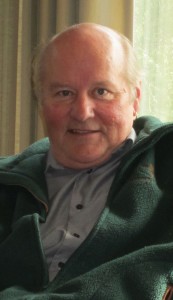
 Ray Rivers writes weekly on both federal and provincial politics, applying his more than 25 years as a federal bureaucrat to his thinking. Rivers was a candidate for provincial office in Burlington where he ran as a Liberal against Cam Jackson in 1995, the year Mike Harris and the Common Sense Revolution swept the province. Rivers is no longer active with any political party. Ray Rivers writes weekly on both federal and provincial politics, applying his more than 25 years as a federal bureaucrat to his thinking. Rivers was a candidate for provincial office in Burlington where he ran as a Liberal against Cam Jackson in 1995, the year Mike Harris and the Common Sense Revolution swept the province. Rivers is no longer active with any political party.
Background links:
Poland and Ukraine Chernobyl
Chernobyl Disaster
European Contamination
Radioactive Deer
Mushroom Hunting –
Mushrooms – More Mushrooms
Even More Mushrooms Chernobyl Survivors More Survivors Nuked Cities More Nukes Cities –

 By Staff By Staff
April 14, 2016
BURLINGTON, ON
An update on the Mount Nemo Plateau Heritage Conservation District Study will be held on Monday, May 2, 2016 at Councillor John Taylor’s Ward 3 spring meeting.
While the City remains committed to protecting the special character of rural Burlington, city staff are recommending that City Council not proceed with the Mount Nemo Study.
At the meeting on May 2, city staff will:
Describe the chronology of events related to the Mount Nemo Study that have brought us to this point
Summarize the community response to the Mount Nemo Study received to date
Outline future opportunities to be involved in rural initiatives, such as the City of Burlington Official Plan Review.
 Where will the arguments to continue with the study come from? Why the shift in thinking? Participants will also have the opportunity to ask questions of staff and offer comments. All questions and comments will be recorded for consideration in current and future City planning initiatives.
Date: Monday, May 2, 2016
Time: 7 – 8 p.m.
Location: Conservation Halton Auditorium, 2596 Britannia Rd, Burlington
Why the change?
Because there is a new planner running the department? Or because cuts have to be made somewhere and this isn’t worth the cost? Will not continuing with the study make any difference?
It was contentious from the beginning.

 By Pepper Parr By Pepper Parr
April 14th, 2016
BURLINGTON, ON
This probably means that warmer weather is going to arrive and stay for a while.
The Cycling Committee has invited residents to attend a series of free cycling seminars to help prepare for the 2016 spring and summer cycling season.
There are four topics that will be covered during the seminars, which run at Burlington Public Library branches this spring.
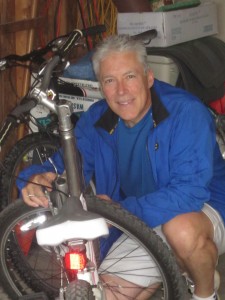 For Rob Narejko a good ride on one of his bikes is better than a night out. A passionate believer in greater use of bicycles, N has served on the city’s cycling committee for some time. He recently led a night ride that had some 20+ people out on the roads at night. Awesome Bike Gear for 2016 – Wednesday, April 27, 7 to 9 p.m. – Central Branch
A variety of local bike shops will share the latest in cool cycling gear for 2016. From stylish cycle-friendly clothing to tech/training gear, to fun and trendy bike accessories and fabulous equipment for family rides. Local bike experts will answer gear questions after the seminar.
 Bikes parked outside a Burlington school – both board of education and city hall would like to see more students biking to school and fewer parents driving their children to school. Bike Maintenance 101
Saturday, April 30, 10 to 11:30 a.m. – Central Branch
Wednesday, May 4, 7 to 8:30 p.m. – Central Branch
Saturday, May 14, 2 to 3:30 p.m. – Alton Branch
Learn about basic bike maintenance that can be done at home. Start the bike season off right with a properly maintained bike for an easier and safer ride. This includes a keynote presentation from Rolling Horse Community Cycle.
Bike Safety
Saturday, May 7, 2 to 3 p.m. – Alton Branch
Monday, May 16, 7 to 8 p.m. – Central Branch
Saturday, June 4, 10 to 11 a.m. – Central Branch
This seminar will cover the rules of the road, must-have bike accessories, the roles and responsibilities of cyclists and motorists, hazards and the proper way to ride on-road bike lanes, bike sharrows and bike paths.
Bike Infrastructure around the World – Wednesday, June 1, 7 to 9 p.m. – Central Branch
Which cities are doing cycling infrastructure right? What creations of pro-cycling design around the world could Burlington learn from? Explore cycling infrastructure projects from around the world.
The seminars are free but sign-up is required.
 For more information about the Burlington Cycling Committee and these free seminars, visit www.burlington.ca/cycling. To sign up for any of the seminars, call Burlington Public Library – Central Branch at 905-639-3611, ext. 1321. For more information about the Burlington Cycling Committee and these free seminars, visit www.burlington.ca/cycling. To sign up for any of the seminars, call Burlington Public Library – Central Branch at 905-639-3611, ext. 1321.
All this attention to getting bikes ready just might do something for the city’s transportation modal split – and if you don’t know what a modal split is – ask the people who tell you how to get your bike ready – this is what they are all about.

 By Staff By Staff
April 13, 2016
BURLINGTON, ON
The inaugural Leading Ladies Charitable Dinner and Speaker Series, organized by the Junior League of Hamilton-Burlington, will take place on May 3, 2016 at LIUNA Station in Hamilton. Doors open at 5:30pm.
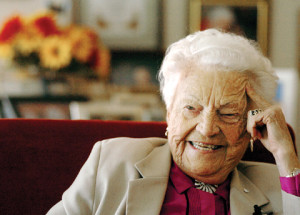 Former Mississauga Mayor Hazel McCallion What makes this a newsworthy event? Former Mississauga Mayor Hazel McCallion is going to take the microphone – and it should be a barn burner of a talk.
Hamilton artist, author and philanthropist Patricia Gagic, will share the stage for an engaging and inspiring evening. The evening will be a dinner and exciting silent auction, with the proceeds supporting the charitable work of the Junior League of Hamilton-Burlington.
“Part of the Junior League’s mission is to develop the potential of women.” says Stephanie Fontaine, President of The Junior League of Hamilton-Burlington Inc. (JLHB).
At 95, Hazel McCallion still outworks colleagues half her age. She is passionate about causes that benefit the community and is thrilled to support the Junior League. “My career has spanned many decades but I have consistently championed education and the development of women leaders, two priorities that I share with the Junior League of Hamilton-Burlington.”
As one of WXN (Women’s Executive Network) Top 100 Most Powerful Women in Canada in 2015, Patricia Gagic’s talents have touched many aspects of the arts and beyond. She is also a dedicated community advocate both locally and internationally. “As a lifetime volunteer and advocate for children around the world, I am excited to share my story in hopes it will inspire others.”
Tickets for the evening (including dinner and speakers) are $100 each (charitable donation receipt available for a portion of the ticket cost), and are available online at www.juniorleague.ca or through the office at 289-337-9526 (Tuesday and Thursday).
The JLHB’s current focus of young women affected by poverty grounds their volunteer efforts and partnerships across the Hamilton-Burlington community.
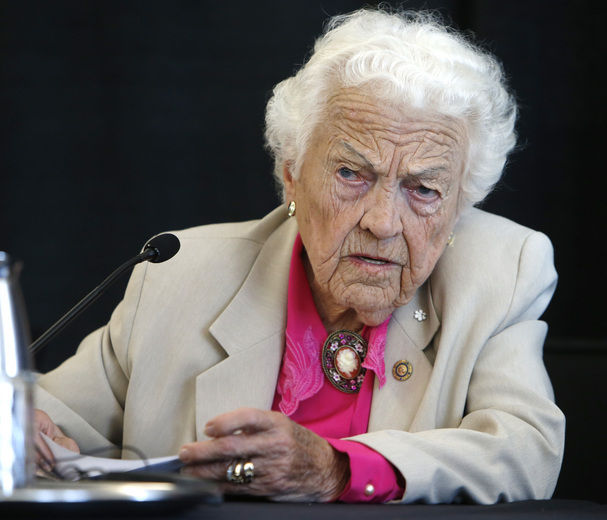 Former Mississauga Mayor Hazel McCallion – she can be as tough as nails when she has to be. While the Junior League of Hamilton-Burlington may be an organization of women committed to voluntarism, developing the potential of women and improving communities through the effective action and leadership of trained volunteers purpose may be exclusively educational and charitable they are going to get an up close and persona look about the role women can and have played in the world of politics.
Hazel is going to lay a little of that political love on them.

|
|
 By Staff
By Staff This couple vowed to quit grocery shopping and to survive solely on foods that would otherwise be thrown away fir six months.
This couple vowed to quit grocery shopping and to survive solely on foods that would otherwise be thrown away fir six months.















 Mountainside Recreation Centre is featured on the cover of the summer guide. Recently renovated, this facility features a 50-meter outdoor pool with a one metre diving board, a double loop waterslide, shade structures, and a splash park, set to open on June 18. The park area of Mountainside features two playgrounds, a skateboard park, a basketball court and nature trails. A virtual tour of Mountainside Recreation Centre and park is available online.
Mountainside Recreation Centre is featured on the cover of the summer guide. Recently renovated, this facility features a 50-meter outdoor pool with a one metre diving board, a double loop waterslide, shade structures, and a splash park, set to open on June 18. The park area of Mountainside features two playgrounds, a skateboard park, a basketball court and nature trails. A virtual tour of Mountainside Recreation Centre and park is available online.



 The classical music we know today came out of that period when Debussy, Ravel, Saint Saens,Faure, Wido rand Satie were both writing and performing.
The classical music we know today came out of that period when Debussy, Ravel, Saint Saens,Faure, Wido rand Satie were both writing and performing.













 John Taylor, Ward 3, has seldom had anyone worth more than the votes they get from family and friends run against him – other than Cory Judson, Taylor has never had to fight off a real candidate.
John Taylor, Ward 3, has seldom had anyone worth more than the votes they get from family and friends run against him – other than Cory Judson, Taylor has never had to fight off a real candidate.








 The city had created a Neighbourhood Community Matching Fund that could put up as much as $5000 into a project that is designed to improve a community.
The city had created a Neighbourhood Community Matching Fund that could put up as much as $5000 into a project that is designed to improve a community.





 The service was not cheap – $100,000 a year – but it is a very useful and for the most part a very accurate tool to measure public opinion.
The service was not cheap – $100,000 a year – but it is a very useful and for the most part a very accurate tool to measure public opinion.
















